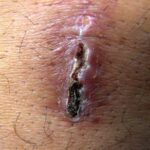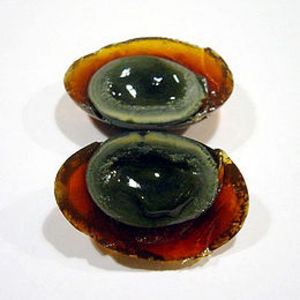Flu season hit our town hard and the schools even harder. And the kids brought it home with them. Everyone in our house was ill, including our 2 month old (who had RSV but that’s another story). And the flu set off our children’s asthma. My husband and I started their normal course of medications, i.e. breathing treatments every 4-6 hours plus a trip to the doctor’s office. Our six year old, Isaac, also developed a stye on his right eye.
That first trip to the doctor’s office was to set off an avalanche of illness in our son, Isaac. The nurse practitioner who we saw that day insisted in pulling out a few of his eyelashes to relieve the pressure of the pus in the stye. It did start to drain while we were there, which was a relief. He was also put on Orapred, a steroid to help calm his asthma (normal course of action for his asthma attacks). We never did figure out if the removal of the eye lashes was what prompted the infection or if he already had the infection.
We were told to put warm compresses on his eye for ten minutes every four hours or so and to keep up with his breathing treatments and oral steroids. That night we kissed our son good night believing all would be well. Except we forgot that steroids like Orapred tend to depress the immune system, a fact we were going to regret.
The next morning, Isaac’s eye was swollen. Actually, it looked like he was on the losing end of a bar fight. Asked if it hurt, he replied that it itched. I knew that the stye on his eyelid shouldn’t have swelled up like that. If anything, the stye should be on its way to being gone. We had no idea that Isaac might have an MRSA, or methicillin-resistant Staphylococcus aureus, infection.
I called the doctor’s office and took him in. By this time, Isaac was running 103 degree fever and his asthma was getting worse. The nurse practitioner upped his asthma meds and made an appointment with an eye specialist for the following day. She even considered hospitalizing him at that point because of his asthma but decided against it. His oxygen level wasn’t low enough to warrant a hospitalization.
We continued with the warm compresses but the swelling continued. By the next day, the day of the eye doctor appointment, Isaac’s eye was completely swollen shut. The lower lid was beginning to swell as well and pus was beginning to weep out of the corners of his eye. The eye doctor put him on antibiotics that day. The next day, his eye began to bleed.
We took him back in to the doctor’s office in the morning for a check up on his asthma. He was doing better but not by much (still running a high fever). When the nurse practitioner tried to open his swollen eye, all we saw was red. At this point, we were told to go immediately to the eye doctor since the NP thought the eyeball itself was infected.
When we got to the eye doctor, we found out that because the tissue around the eyeball was so swollen that the inside of the eye orbit was being stretched and pulled apart. Thus the bleeding.
Don’t worry, we were told. How could we not worry? At this point, I was pretty sure that the antibiotics weren’t doing anything but I didn’t say anything. After all, the doctor knew what he was doing, right? The eye doctor said if he wasn’t better by Friday to bring him back in.
Thursday dawned and Isaac’s eye was worse. His upper eyelid was so swollen that it actually rested on his cheekbone. You couldn’t even see his lower eyelid (which was very swollen as well). I immediately called the eye doctor’s office and took him in. The doctor we had been seeing was not in that day and his colleague took a look at Isaac. She immediately hospitalized Isaac and ordered a CT scan of his head. By this time, Isaac had had an MRSA infection for 5 days without an effective antibiotic.
Once at the hospital, it took nearly 8 hours for Isaac to be admitted. He had to go through the emergency room rather than admitting and it took longer. He was put on Vancomycin, one drug that is able to combat MRSA. His CT scan showed that his ears and sinuses were infected as well. The major concern was that the infection was draining down the major vessels by his brain and that he would develop a brain infection.
They eventually got him into a room. Did I mention that it was flu season? The pediatrics wing was overflowing with sick babies. Anyway, once he was in a room, tests of the pus coming from his eye showed conclusively that he had MRSA. MRSA, according to the Center for Disease Control, is “a type of staph that is resistant to antibiotics” that includes “methicillin and other more common antibiotics such as oxacillin, penicillin, and amoxicillin.
(http://www.cdc.gov/ncidod/dhqp/ar_mrsa_ca_public.html#2)
My husband, my sister and I all took turns staying with him, praying that he would get better. Eventually, the fever came down, the coughing eventually faded, and most importantly, the swelling began to subside. He was hospitalized for four days, hooked up to monitors, suffering blood tests, and went through two IVs (the original IV fell out of his arm and they had to put in a new one).
That Sunday, although his eye was not completely back to normal, Isaac was released from the hospital. He was put on oral antibiotics to kill of the last of the MRSA. So far, he has gone through three 14 day courses of Septra, an oral antibiotic that can kill the MRSA bacteria, and one 3 week course of Rifampin, another oral antibiotic. His eye is looking much better, almost like he never had an infection.
The other day, his two year old brother woke up with a stye…same eye. I nearly had a panic attack. We immediately began compresses and told ourselves if the swelling got worse we would immediately go to the emergency room. Thankfully, it didn’t get to that point. I now live in fear that I’ll lose my children to this insidious bacteria. Even though we’ve cleaned everything with bleach and Lysol and follow the cleanliness guidelines, the MRSA may still come back. It’s something that we’ll all have to live with for a long time to come.
Reference:
- CDC Information about Community-Associated MRSA (www.cdc.gov/ncidod/dhqp/ar_mrsa_ca_public.html#2)








